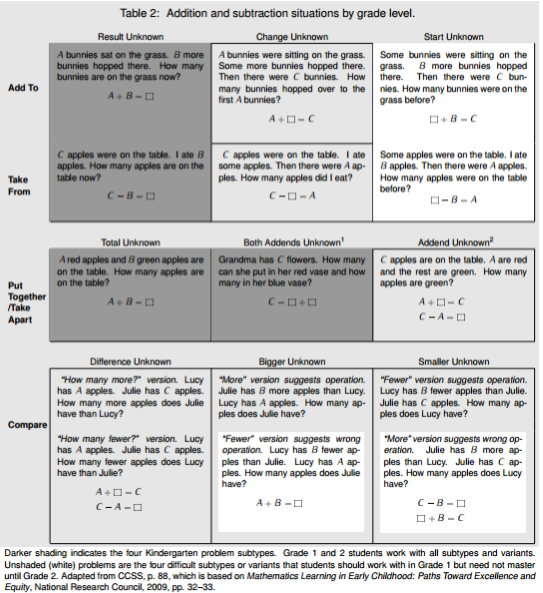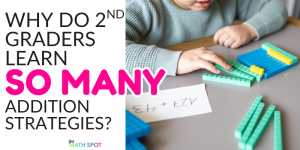
Solving word problems is hard.
In a world where reading comprehension, logical thinking, math computation, and visualization come together, word problems were born. It is no wonder that many teachers reach for “keyword strategies” to help students decide which operation to use.
At first glance, keywords seem like a logical shortcut. But relying on them will often make solving word problems more difficult, especially as problem types become more complex.
The Appeal of Word Problem Keywords
Teachers want math instruction to make sense, click, and come alive for students. It can be tempting to teach tricks in the interest of helping students get to the right answer quickly.
Common keyword lists look something like this:
Addition: add, sum, total, plus, and, in all, altogether, together, more
Subtraction: difference, take away, minus, fewer, less, took, gave away, leftover
The problem? These words don’t always appear in every problem type. Sometimes they even suggest the wrong operation.
Why Keywords Break Down
To see how keywords fall short, let’s compare them against actual problems from the progression of addition and subtraction problem types in K–2.
Kindergarten
CCSS.MATH.CONTENT.K.OA.A.2
Solve addition and subtraction word problems, and add and subtract within 10, for example, by using objects or drawings to represent the problem.
In Kindergarten, many problems are “put together,” “take apart,” “add to,” or “take from” situations where the result is the unknown.
4 bunnies sat on the grass. 5 more bunnies hopped over. How many bunnies are on the grass now?
Keyword suggests addition. Addition works here.
10 apples were sitting on the table. I ate 4. How many are on the table now?
“Ate” could suggest subtraction, but not all students will connect that word to the operation.
Grandma has 10 apples. How many can she put in the red vase and how many in the blue vase?
No keyword at all.
Conclusion: In Kindergarten, keywords sometimes work, but they are not reliable enough to solve every problem type.
First Grade
CCSS.MATH.CONTENT.1.OA.A.1
Use addition and subtraction within 20 to solve word problems involving situations of adding to, taking from, putting together, taking apart, and comparing, with unknowns in all positions, for example, by using objects, drawings, and equations with a symbol for the unknown number to represent the problem.
By Grade 1, students are expected to solve problems with unknowns in all positions.
6 bunnies were on the grass. Some more bunnies hopped there. Then there were 12 bunnies. How many hopped over?
Keyword suggests addition, but subtraction is actually needed to solve.
Lucy has 16 apples. Julie has 9 apples. How many more apples does Julie have than Lucy?
Keyword “more” suggests addition, but subtraction is needed.
Conclusion: In Grade 1, many problems have no keyword at all. Others have keywords that point students in the wrong direction entirely.
Second Grade
CCSS.MATH.CONTENT.2.OA.A.1
Use addition and subtraction within 100 to solve one- and two-step word problems involving situations of adding to, taking from, putting together, taking apart, and comparing, with unknowns in all positions, for example, by using drawings and equations with a symbol for the unknown number to represent the problem.
By Grade 2, multi-step problems and the most complex compare problem types are added.
Lucy has 19 fewer apples than Julie. Lucy has 36 apples. How many apples does Julie have?
Keyword “fewer” suggests subtraction, but addition is needed.
Julie has 63 more apples than Lucy. Julie has 89 apples. How many apples does Lucy have?
Keyword “more” suggests addition, but subtraction is needed.
In fact, in the problem type diagram for these situations, the descriptions explicitly note “fewer suggests wrong operation” and “more suggests wrong operation.”
What to Do Instead
- Instead of teaching students to hunt for keywords, focus on helping them understand the structure of each problem type, such as “add to,” “take from,” “put together,” “take apart,” and “compare.” You can read more about why problem types matter in this post.
- Use numberless word problems to help students focus on the context and relationships in the problem before deciding on the numbers and operations. Removing the numbers at first encourages discussion about what is happening, what is known, and what needs to be found.
- Link word problems to concrete and representational models. Act out problems, model with manipulatives, and then represent the situation with drawings and diagrams before moving to equations.
- Connect each problem type to both a situation equation (matching the story) and a solution equation (the math you do to solve). Many students struggle to see this difference, and without it, they are more likely to rely on misleading keywords.
- Spiral practice across problem types instead of teaching one type for a block of time and moving on. Mixing types forces students to think about the structure every time they solve, building true flexibility.
Keywords may feel like a shortcut, but they lead students into dead ends as soon as problems get more complex. By teaching students to understand problem structures and connecting those structures to models and equations, you prepare them to solve any problem type with confidence.
Word Problem Resources







